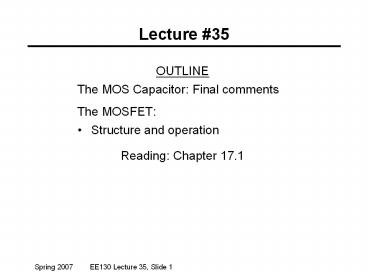OUTLINE - PowerPoint PPT Presentation
1 / 13
Title:
OUTLINE
Description:
Lecture #35 OUTLINE The MOS Capacitor: Final comments The MOSFET: Structure and operation Reading: Chapter 17.1 Bias-Temperature Stress Measurement Clarification ... – PowerPoint PPT presentation
Number of Views:52
Avg rating:3.0/5.0
Title: OUTLINE
1
Lecture 35
- OUTLINE
- The MOS Capacitor Final comments
- The MOSFET
- Structure and operation
- Reading Chapter 17.1
2
Bias-Temperature Stress Measurement
Used to determine mobile charge density in MOS
dielectric (units C/cm2)
Na located at lower SiO2 interface ? reduces VFB
DVFB
Na located at upper SiO2 interface ? no effect
on VFB
Positive oxide charge shifts the flatband voltage
in the negative direction
3
Clarification Effect of Interface Traps
Donor-like traps are charge-neutral
when filled, positively charged when
empty Positive oxide charge causes C-V curve
to shift toward left (more shift as VG
decreases)
(a)
(c)
(b)
(a)
(b)
Traps cause sloppy C-V and also greatly degrade
mobility in channel
(c)
4
Invention of the Field-Effect Transistor
In 1935, a British patent was issued to Oskar
Heil. A working MOSFET was not demonstrated
until 1955.
5
Modern Field Effect Transistor (FET)
- An electric field is applied normal to the
surface of the semiconductor (by applying a
voltage to an overlying electrode), to modulate
the conductance of the semiconductor - Modulate drift current flowing between 2 contacts
(source and drain) by varying the voltage on
the gate electrode
6
The Bulk-Si MOSFET
Metal-Oxide-Semiconductor Field-Effect Transistor
Gate
- Desired characteristics
- High ON current
- Low OFF current
Source
Drain
Substrate
M. Bohr, Intel Developer Forum, September 2004
- Current flowing between the SOURCE and DRAIN is
controlled by the voltage on the GATE electrode
- N-channel P-channel MOSFETs operate in a
complementary manner - CMOS Complementary MOS
7
N-channel vs. P-channel
NMOS
PMOS
N
N
P
P
- For current to flow, VGS gt VT
- Enhancement mode VT gt 0
- Depletion mode VT lt 0
- Transistor is ON when VG0V
- For current to flow, VGS lt VT
- Enhancement mode VT lt 0
- Depletion mode VT gt 0
- Transistor is ON when VG0V
8
Enhancement Mode vs. Depletion Mode
Enhancement Mode
Depletion Mode
Conduction between source and drain regions is
enhanced by applying a gate voltage
A gate voltage must be applied to deplete the
channel region in order to turn off the
transistor
9
CMOS Devices and Circuits
- When VG VDD , the NMOSFET is on and the
PMOSFET is off. - When VG 0, the PMOSFET is on and the NMOSFET
is off.
10
Pull-Down and Pull-Up Devices
- In CMOS logic gates, NMOSFETs are used to connect
the output to GND, whereas PMOSFETs are used to
connect the output to VDD. - An NMOSFET functions as a pull-down device when
it is turned on (gate voltage VDD) - A PMOSFET functions as a pull-up device when it
is turned on (gate voltage GND)
VDD
A1 A2 AN
Pull-up network
PMOSFETs only
input signals
F(A1, A2, , AN)
A1 A2 AN
Pull-down network
NMOSFETs only
11
CMOS NAND Gate
VDD
A B F
0 0 1
0 1 1
1 0 1
1 1 0
A
B
F
A
B
12
CMOS NOR Gate
VDD
A B F
0 0 1
0 1 0
1 0 0
1 1 0
A
B
F
A
B
13
CMOS Pass Gate
A
Y
Y X if A
X
A

























![[READ]⚡PDF✔ Black Letter Outline on Contracts (Black Letter Outlines) 5th Edition PowerPoint PPT Presentation](https://s3.amazonaws.com/images.powershow.com/10044064.th0.jpg?_=20240531080)


![[PDF] DOWNLOAD FREE Clinical Outline of Oral Pathology: Diagnosis and PowerPoint PPT Presentation](https://s3.amazonaws.com/images.powershow.com/10076578.th0.jpg?_=20240711025)


